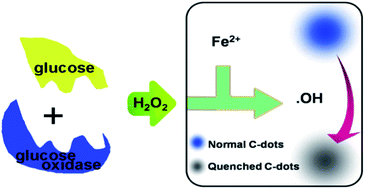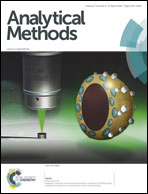Fluorescence turn-off detection of hydrogen peroxide and glucose directly using carbon nanodots as probes†
Abstract
In this paper, carbon nanodots (C-dots) were prepared using a hydrothermal method and were characterized by UV-vis absorption spectroscopy, fluorescence spectroscopy, transmission electron microscopy and atomic force microscopy. The as-prepared C-dots show a blue emission at 410 nm and the diameter of the C-dots was in the range from 4 nm to 10 nm. The fluorescence of the as-prepared C-dots is linearly quenched by H2O2 in the presence of Fe2+. Hence, the C-dots can be directly used for the fluorescence detection of H2O2. The production of H2O2 from the oxidization of glucose by glucose oxidase results in the fluorescence quenching of C-dots in the presence of Fe2+, which can be used to detect glucose. In this paper, we first directly used C-dots as a fluorescence probe for the turn-off detection of H2O2 and glucose in the presence of Fe2+. After the experimental conditions were optimized, it was found that the fluorescence of the C-dots was quenched linearly by H2O2 over the concentration range 0.025–50 μM. What is more, a linear correlation was established between ΔF and the concentration of glucose in the range from 0.05 to 100 μM.


 Please wait while we load your content...
Please wait while we load your content...